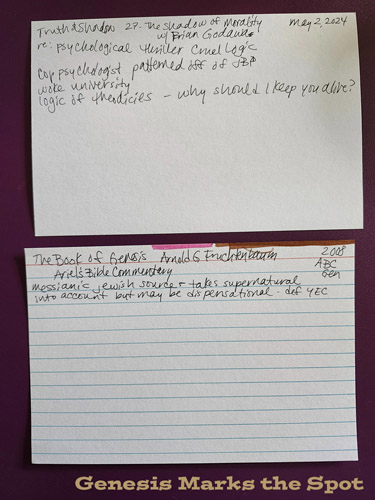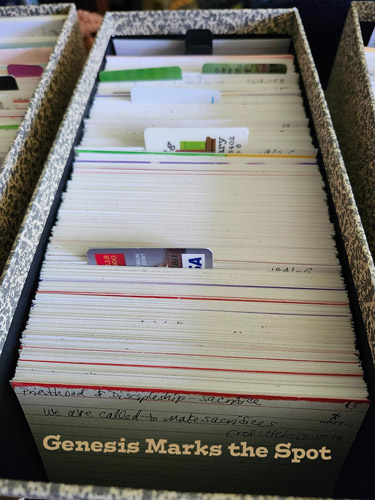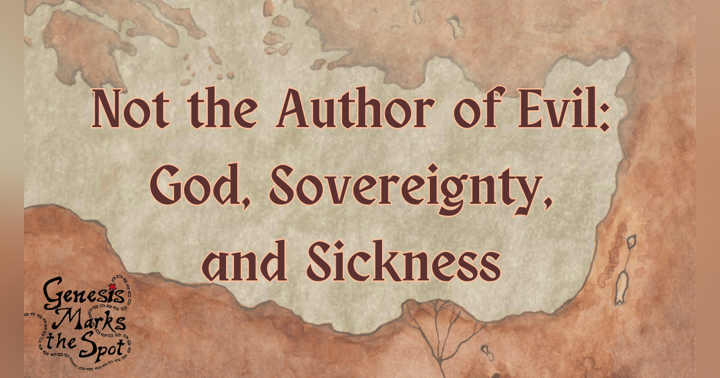The Best Note-Taking System EVER!

I usually try to avoid hyperbole, but in this case, I really think it's true--this is the best note-taking system ever. In episode 78 of Genesis Marks the Spot, I explain the way that I use the Zettlekasten note-taking system and why I use it the way that I do (with physical notes). The beauty of it is manifold...no, you really don't have to be an "organized" person to use it (though there are some regular rules and aspects to the system), and you also don't need to use the system constantly for it to be a useful tool. Pick it up, put it down and let it gather some dust, pick it up again, it doesn't matter. It's just a tool, but it's an insanely useful one.
The point of this note-taking system is not for mere data-gathering, but for true critical thinking of your own. Organized thinking that is not boxed into categories is powerful. The main problem with "thinking" is having all of your ideas available to you at once. This system makes "hyperlinking" ideas a conscious process rather than relying on your brain to bring together disconnected ideas into a new concept.
I won't explain the system fully in this blog post, because I've done what I hope is a reasonable job of that in my episode (if you want clarification or more detail on something, feel free to message me!). But I wanted to have a place where I could show images of my real notes to give you a better grasp of what this looks like, practically. This is how I do it and I encourage everyone to make the system their own in their unique ways that works for them.
To stave off common questions, here are some things I address in the episode about this system:
- Yes, you can use the system digitally!
- I use physical notes because:
- I spend a lot of time with my notes; if I did that digitally, I'd never be off a computer/phone and accessing my notes would require digital connection
- Physical notes allow me to organize and reorganize thoughts PHYSICALLY, which literally aids in thinking
- Even with thousands of cards, I can locate an idea very easily via my "entry points" in my index
- I've used this system for years and do not feel I have an overabundance of notes
- Overthinking is a common problem when setting up the system, but just start anywhere that you currently are, with any ideas that you currently have (don't try to pre-load a bunch of past thoughts into your notes)
- The catalog numbering system looks complex, but it's simply a way to start the web of ideas
Types of Notes
Literature Notes
These should be brief, do not have to be exhaustive of everything you consume, and are only there as aids to help you track things you feel would be useful. Here are some examples using 4x6 index cards.
Fleeting Notes
Fleeting notes are the notes that you take in the moment--reading, listening, or just whenever an idea comes to you. They are not to be kept and are to be used to make your permanent "slip notes."
Slip Notes
Slip notes are your permanent notes. Ideally, they are written in your own words (not just taking quotes from resources) and will have catalog numbers to keep the notes accessible and connected to one another. These are a representative sample of my own notes, pulled entirely randomly from my boxes, and are a true look at how much information I put on notes. Note the catalog number in the top right corner and a few of these have "hyperlinks" to other notes (seen on the bottom).
**A note I didn't mention in my episode: do not write notes on the back of your cards. You want the idea/concept/thought to be fully present to you when you look at the card. The back can be used for hyperlinks (see below) or other data you might wish to record for the note (ie, I make a note of the episode I use the information).
There are times when I write more; here is a sample of some of my longer notes.
Catalog Numbering System
The catalog numbers are, perhaps, the most complex part of this whole thing. Each note should be connected in thought to a previous note. (It's possible that, especially when you don't have enough notes, you can't find a connection to another note--in that case, just give it a new number.)
Begin with whole numbers (1, 2, 3, 4...), but don't go to high! You'll soon start inserting new cards behind existing ones using a label that alternates numbers and letters. For instance, if you have a card that goes after card 2, but you've already got a card 3, then label the new card 2a. When you have a card that goes behind 2a, but you already have 2b, then you'll label that one 2a1. Here is an example of a series of notes from my own box. (I find that as the label gets long, it helps my eyes to add some dashes.)
Your slip notes will connect in a variety of ways--either a question or response following an idea you've already written down, or the connection can be far more tenuous than that.
Indexing System
One of the most vital aspects of this system is an index that will provide "entry points" into your slip card box. You might find a digital index the way to go, but I found it frustrating to have to turn from my notes to my phone to look at my digital index, so I've been very happy with my physical index (which I re-write every 6 months or so as I add things to it). Actually I have two sets of indexes--one is arranged in numerical/categorical order, and the other is topical. I use the topical index far more often.
The topical index is arranged in categories, with subcategories and "entry points" listed on that card. I have found this an amazingly efficient way to access my notes.
Hyperlinks
Slip notes are hyperlinked together by writing the catalog number of other cards on the bottom of each slip note. (You may write them on the back, as well, if you don't feel you have enough space on the bottom, but mark the bottom of the card in some way so that you know to look at the back for hyperlinks as desired--you don't want to have to flip every card around to see if you have links.)
Slip Note Boxes
Some details on the boxes I use. I have found that my local Staples keeps them in stock, but you can also order them on Amazon (which is usually cheaper). Make sure that the box has an "adjustable follower" so that the box can hold a smaller number of cards.
Tip: Old credit card/debit cards, hotel room keys, etc, can be used to temporarily mark spots--do not use permanent tabs! You're not trying to "box" your notes into categories or sections. You want your ideas to connect naturally and in unpredictable ways with one another.
Tip: Swipe the top of particular cards to make finding really important sections easy. These sections will not be the only place to find ideas of these topics, ideally, because we want to create an interlocking web of ideas, but these are another method of "entry" into your notes.
Tip: Another way to temporarily mark a section that you're working in your box is to flip some notes 90 degrees.
If you're curious, here's the current state of my slip note boxes!
I absolutely love using this system. In fact, I think I'd have a hard time doing this podcast without it! I'd love to hear if you guys find this useful--and I'd love to see pictures of your slip note boxes!!



















